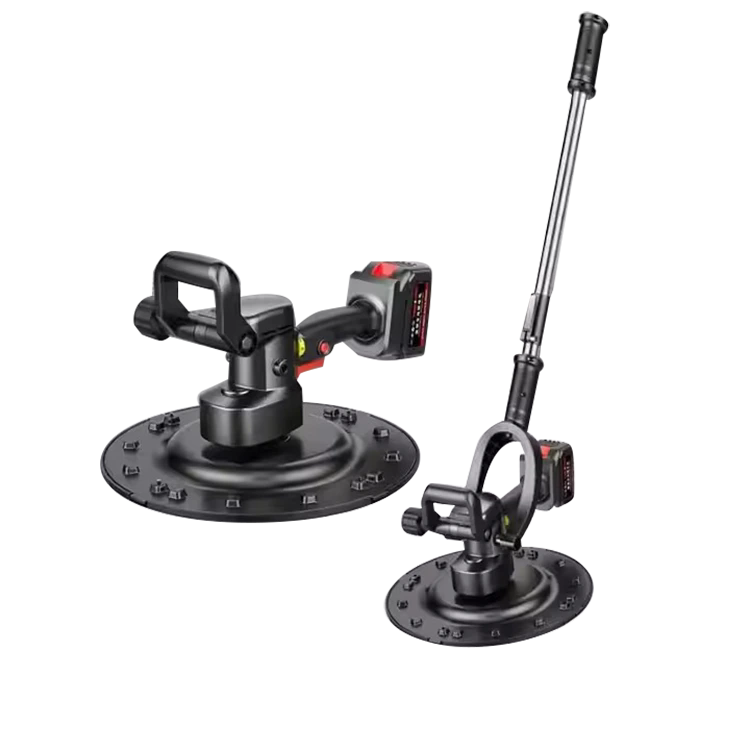Plastering Electric Trowel: The Ultimate Tool for a Smooth Finish
2025-04-29
Plastering is an essential part of building and renovation work, and achieving a smooth, even finish is crucial for both the aesthetic and functional aspects of a surface. Traditionally, plastering has been a manual process requiring significant skill and effort. However, with the advent of the electric trowel, the task has become quicker, more efficient, and less physically demanding.
In this blog post, we'll dive into the features, benefits, and uses of a plastering electric trowel, and why it’s becoming a favorite tool for both professionals and DIY enthusiasts.

What is a Plastering Electric Trowel?
A plastering electric trowel is a powered tool designed to apply, smooth, and finish plaster on walls and ceilings. It functions similarly to a traditional trowel, but with the added benefit of electric power, making the process much faster and less labor-intensive. The electric trowel features a rotating blade or trowel head that helps to spread and smooth plaster, joint compound, or other finishing materials over a surface.
Electric trowels come in different sizes and designs, from smaller, handheld versions for tight spots to larger, floor-standing models for covering larger surfaces.
How Does a Plastering Electric Trowel Work?
An electric trowel works by using a motor to rotate or vibrate the trowel blade, which helps in applying and smoothing the plaster onto the surface. The key advantages are:
1. Automatic Spreading: The tool spreads plaster evenly across walls or ceilings, preventing uneven application or visible lines.
2. Smoothing Action: The motorized mechanism ensures that the plaster is smoothed out quickly and uniformly.
3. Vibration or Rotation: Many electric trowels use vibration or rotating motion, which reduces the effort needed by the user and creates a smoother finish.
4. Adjustable Settings: Many models come with adjustable speed controls and interchangeable trowel heads to accommodate different surfaces and plaster thicknesses.
Benefits of Using a Plastering Electric Trowel
1. Time-Saving
One of the biggest advantages of using an electric trowel is the speed at which it can cover large areas. Manual plastering requires a lot of time and energy, especially for smoothing and finishing surfaces. The electric trowel’s motorized action speeds up the process significantly, making it ideal for larger projects or when time is of the essence.
2. Consistency and Even Finish
Achieving a smooth, even finish with a manual trowel can be challenging, especially for those without a lot of experience. The electric trowel removes much of the guesswork, offering consistent results. The motorized blade ensures that the plaster is spread evenly, resulting in a smooth surface that would be hard to replicate manually.
3. Less Physical Effort
Plastering is physically demanding, and using a manual trowel requires constant arm and wrist movement. With an electric trowel, the tool takes over much of the work, reducing physical strain and helping to prevent fatigue, especially for large jobs or long durations of plastering.
4. Improved Control and Precision
Electric trowels provide better control over the plastering process. Whether you’re smoothing a surface, applying a second coat, or finishing the corners of a wall, the tool’s design and motorized action give you greater precision than manual methods.
5. Versatility
While primarily used for plaster, many electric trowels can also be used with other materials, such as joint compound, cement-based products, or even thin coatings for walls. This makes them versatile tools for various surface finishing applications.
Key Features to Look for in a Plastering Electric Trowel
When choosing a plastering electric trowel, there are several important features to consider:
1. Motor Power
The power of the motor directly affects the performance of the electric trowel. A stronger motor ensures that the tool can handle thicker plaster and cover larger areas more efficiently.
2. Speed Settings
Adjustable speed settings are a useful feature, as different plastering tasks may require different speeds. Slower speeds may be needed for smoothing and finishing, while faster speeds can be used for the application.
3. Blade Size and Material
The size of the trowel blade is crucial for different surfaces. A larger blade covers more area, while a smaller blade offers better precision in tighter spots. Also, ensure that the blade is made of durable material, such as stainless steel, for long-lasting performance.
4. Weight and Ergonomics
Since plastering can take a considerable amount of time, the weight and ergonomics of the tool are important. Look for a model that is lightweight and comfortable to handle, with an ergonomic grip to reduce fatigue.
5. Durability
Since plastering tools are subjected to tough conditions, choose an electric trowel that is built to last. A sturdy build and high-quality components ensure the tool will withstand the wear and tear of plastering jobs.
6. Noise Level
Some electric trowels can be noisy. If you’re working in a sensitive environment or need to reduce noise, look for quieter models.
How to Use a Plastering Electric Trowel
Using a plastering electric trowel is relatively straightforward, but like any tool, it requires some practice to achieve the best results. Here’s a quick guide on how to use it:
1. Prepare the Surface
Before using the electric trowel, ensure that the surface is clean and free of dust or debris. For best results, apply a primer or bonding agent if necessary, especially for smooth or non-porous surfaces.
2. Apply Plaster
Use a traditional trowel to apply a thin layer of plaster on the surface. The electric trowel will help smooth it out and give you an even finish.
3. Start the Electric Trowel
Switch on the electric trowel and begin smoothing the plaster. Move the tool slowly across the surface, ensuring that the plaster is evenly spread. Adjust the speed if needed to suit your requirements.
4. Finishing Touches
Once the initial layer is smooth, you can apply additional layers and continue using the trowel for an even, perfect finish. It’s important to allow each layer to dry before applying the next one.
5. Clean the Tool
After use, make sure to clean the electric trowel thoroughly to remove any plaster residue. This will ensure its longevity and prevent clogging in future projects.
Conclusion
The plastering electric trowel is a fantastic tool that enhances the plastering process, making it faster, easier, and more efficient. Whether you’re a professional plasterer or a DIY enthusiast, this tool can help you achieve a smooth, even finish with minimal physical effort. By selecting a high-quality electric trowel that fits your needs, you can enjoy better results and save time on your plastering projects. Happy plastering!


